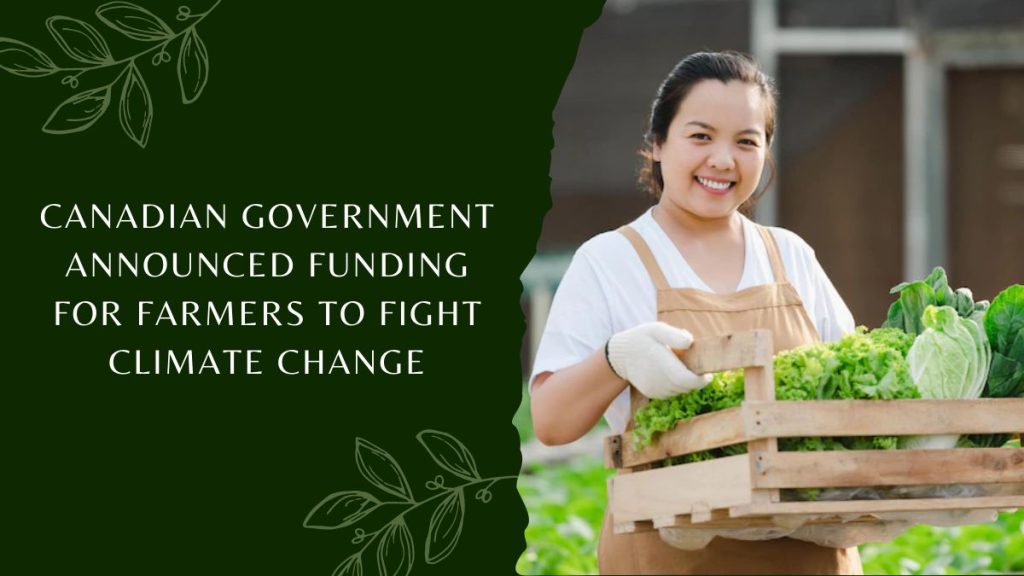
The On-Farm Climate Action Fund, which was first proposed in Budget 2021, is designed to assist farmers in combating climate change. It is part of Canada’s Agricultural Climate Solutions effort, overseen by Natural Resources Canada, Environment and Climate Change Canada, and Agriculture and Agri-Food Canada. It falls under the $4 billion Natural Climate Solutions Fund.
Investing in agriculture is one of the most brilliant things the government can do to fight climate change. Not only does it help reduce emissions, but it also helps ensure food security for Canadians.
The Honorable Marie-Claude Bibeau, Minister of Agriculture and Agri-Food, and Francis Drouin, Parliamentary Secretary to the Minister of Agriculture and Agri-Food and Member of Parliament for Glengarry–Prescott–Russell, announced today federal funding of up to $182.7 million for 12 recipient organizations to deliver the On-Farm Climate Action Fund across Canada to support farmers in their efforts to combat climate change.
Climate change is already having a significant impact on Canadian farmers, and it’s only going to get worse. That’s why the government invests in programs to help them adapt to the changing climate. Canada’s federal government has announced funding for farmers to fight climate change. The $300 million investment is part of a larger, long-term plan to help Canada adapt and mitigate the effects of climate change.
Agriculture will use the money and Agri-Food Canada (AAFC) to fund research on increasing crop yields, developing new agricultural technology, improving soil health, and providing incentives for producers who adopt sustainable farming practices.
It’s part of the government’s overall effort to reduce emissions from agriculture by 80% below 2005 levels by 2050. The Canadian government has announced that it will be providing farmers with funding to help them fight climate change. It is a significant step in the right direction, and it is hoped that other countries will follow Canada’s lead on this issue.
Climate change is one of the biggest threats facing our planet, and we must do everything we can to fight it. The Canadian government is stepping up, and helping farmers do their part is commendable. It is clear that we need to take action on climate change, and this funding will go a long way towards helping us achieve that goal.
What Is Climate Change?
Climate change refers to a broad array of environmental degradation predicted to result from increasing levels of atmospheric CO2, including global warming, alterations in precipitation, sea-level changes, and more extreme weather events. The main consequences of climate change include more extreme weather events, such as floods and hurricanes; changes in precipitation, which could lead to droughts or flooding; and sea-level changes, which could cause widespread flooding. Additionally, climate change is projected to increase the spread of diseases and pests, negatively impacting human health and agricultural production.
Climate change is already affecting the world in several ways. For example, we see more extreme weather events, such as floods and hurricanes, and changes in precipitation, leading to droughts or flooding. Additionally, climate change contributes to the spread of diseases and pests and harms agricultural production.
There are several ways that climate change can be addressed, including reducing greenhouse gas emissions, investing in renewable energy sources, and promoting energy efficiency. In addition, adaptation measures can help farmers and other stakeholders prepare for the impacts of climate change.
How Climate Change Affects Agriculture?
The main consequences of climate change for agriculture include changes in precipitation, which could lead to droughts or flooding; alterations in the timing and intensity of rainfall; increased frequency of extreme weather events, such as floods and hurricanes; and changes in the distribution of pests and diseases. These changes could negatively impact crop yields, livestock production, and food security.
How Does Climate Change Specifically Affect Canada?
It is projected that Canada will experience warmer temperatures, increased precipitation in the winter and spring, and more extreme weather events, such as floods and hurricanes. These changes are likely to negatively impact agricultural production, water resources, and human health.
Why Is the Canadian Government Funding Farmers?
Farmers in Canada play an important role in creating a healthy environment and a more sustainable agriculture sector. The funding will help farmers export their products to new markets. It is important because climate change is not just a Canadian problem; it’s a global problem. Canadian farmers are some of the best in the world, and they’re up for the challenge of adapting to climate change. With this funding, they’ll be able to continue producing food that everyone can rely on, no matter what the weather throws at us. The Canadian government’s new funding will help farmers do just that by supporting projects like agroforestry, cover crops, and manure management. These initiatives will improve soil health and fertility while reducing the amount of carbon dioxide that is released into the atmosphere
Farmers are on the frontlines of climate change, as they already feel the impacts of shifting weather patterns and the increased severity of storms. They are also uniquely positioned to help mitigate these impacts by implementing practices that reduce greenhouse gas emissions and enhance resilience to climate change. That is why they must receive funding to help them adapt to these changes.

What Is the Amount Funded by the Federal Government?
Agriculture and Agri-Food Canada has announced a $550 million investment to develop and implement clean technology and good management practices. In addition to the Agricultural Climate Solutions (ACS) – On-Farm Climate Action Fund, new programs to address environmental issues have been launched, including the $185 million Agricultural Climate Solutions (ACS) – Living Labs program to support carbon sequestration and GHG emission reduction. The $165.7 million Agricultural Clean Technology Program supports clean technology research, development, and adoption.
What Are the Target Areas of Funding to Support Canadian Farmers?
Direct assistance to farmers will be provided in the following areas:
1. Cover-Cropping: Payment-per-acre to cover adoption or related expenditures such as seeds and equipment is an example of cover cropping. Cover crops, such as clover and alfalfa, are planted to cover the soil rather than be harvested. Cover cropping is the practice of planting crops in between rows of other crops to protect the soil from erosion and improve its quality. The cover crop can be either a cool-season or warm-season plant, depending on the climate.
Cover cropping is essential because it helps to protect the soil from erosion and improve its quality. It is important because healthy soil is essential for agricultural production, and erosion can damage the soil’s ability to support plant growth. Additionally, cover crops can provide shelter and food for beneficial insects and birds, which helps to promote biodiversity.

2. Nitrogen Management: Agronomic services, such as developing farm-specific nutrient management plans, equipment adaptations for fertilizer application in fields, and soil sample and analysis, are just a few examples. Nitrogen management is the process of controlling the amount of nitrogen that enters the soil. It is essential because too much nitrogen can lead to nutrient pollution and damage the environment. Nitrogen management techniques include using organic fertilizers, planting cover crops, and precision farming tools.
Nitrogen management is essential because it helps to protect the environment from nutrient pollution. Excess nitrogen can cause severe damage to water bodies, including rivers, lakes, and estuaries, impairing plant growth and causing health problems for people and animals. By using nitrogen management techniques, farmers can reduce the amount of nitrogen that enters the soil, which helps to protect the environment.
3. Rotational Grazing: Agronomic services, such as developing grazing management plans, interior cross fencing, water system infrastructure, and legume and forage seeds, are just a few examples. The process of containing and moving livestock through grassland to allow forage plants to recuperate, deepen their root systems, and promote soil health is known as rotational grazing.
Rotational grazing is a management system in which livestock are regularly moved to different pasture areas. It is essential because it helps to improve the soil quality and prevent overgrazing. Rotational grazing also helps conserve water and reduce the amount of manure entering the environment.
Rotational grazing is essential because it helps to improve soil quality and prevent overgrazing. Overgrazing can damage the grasses and other plants that make up the pasture and lead to soil erosion. Additionally, rotating livestock through different pasture areas helps conserve water and reduce the amount of manure that enters the environment.
How Is This Fund Assisting Canadian Farmers?
The Fund is assisting Canadian farmers by providing financial assistance to help them adapt to the effects of climate change. These measures include installing irrigation systems, implementing nitrogen management strategies and rotational grazing, and diversifying their crops and livestock production. The Fund also provides technical support to help farmers implement these measures successfully. Additionally, the Fund helps to raise awareness of climate change. Individual application intakes will allocate funding among recipients around the country. The Fund will assist in overcoming barriers to broader adoption, including upfront implementation costs, a lack of risk protection, minimal or delayed returns on investment, and inadequate information and agronomic services available. Farmers throughout Canada are urged to use the On-Farm Climate Action Fund Web Tool to determine which beneficiary organization best fits their requirements and geographic area.
What Is the Goal Set by the Canadian Government Through This Fund?
By 2024, the Fund-supported activities are estimated to cut GHG emissions by up to 2 million tonnes. The Government of Canada is taking serious action to combat climate change and build a robust and prosperous future for all Canadians in collaboration with Canadians and communities. The agriculture sector in Canada now accounts for 10% of the country’s GHG emissions, and it can play a critical role in decreasing national GHG emissions and boosting climate resiliency. The government’s reinforced climate plan, A Healthy Environment and a Healthy Economy aim to reduce greenhouse gas emissions by 40-45 percent below 2005 levels by 2030 and achieve net-zero emissions by 2050.
This Fund aims to help Canadian farmers adapt to the impacts of climate change. By providing financial assistance and technical support, the Fund helps farmers implement adaptation measures to improve their resilience to climate change. The Fund also raises awareness of climate change and its impacts on agriculture, which helps to ensure that farmers are prepared for the future.
What Is the Aim of this Fund?
This Fund aims to help farmers adapt to climate change and improve their resilience to its impacts. The Fund provides financial assistance and technical support to help farmers implement adaptation measures, which helps to protect the environment and sustain agriculture. Additionally, the Fund helps raise awareness of climate change and its impacts on agriculture.

To Sum It All up:
Canadian farmers have announced a new funding program to help them tackle climate change. The Fund will provide financial assistance to farmers to implement adaptation measures, including installing irrigation systems, implementing nitrogen management strategies and rotational grazing, and diversifying their crops and livestock production. Additionally, the Fund will provide technical support to help farmers implement these measures successfully. The Fund aims to improve the resilience of Canadian farms to climate change and promote sustainable agriculture practices. It’s a win-win situation, and we should be proud of our government for taking this vital step. The Canadian government’s funding for farmers to fight climate change is a significant step in the right direction.
We all too must do our part to address this critical issue. We need to take steps to reduce our emissions footprint and invest in renewable energy sources, such as solar and wind power. We also need to support initiatives that help farmers adapt to the changing climate. This new Fund is a great start, and we hope that it will be successful in helping Canadian farmers become more resilient to climate change.






Leave a Reply